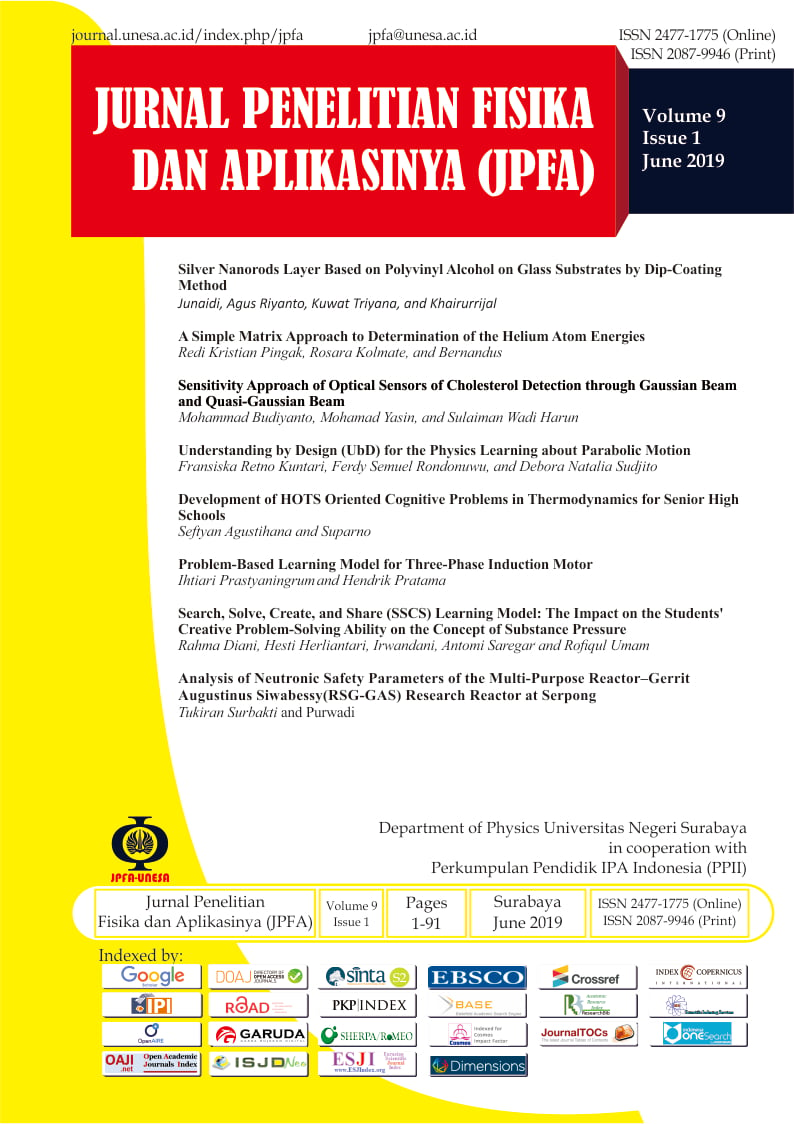Problem-Based Learning Model for Three-Phase Induction Motor
DOI:
https://doi.org/10.26740/jpfa.v9n1.p55-64Keywords:
Problem Based Learning, Induction Motor, three phase, understanding, electromagnetic fieldAbstract
This study aims to examine the Problem-Based Learning(PBL) model to improve the understanding of electromagnetic induction material in three-phase induction motor. Most of the students attending the Electrical Machine course have low understanding upon the working principles of the three-phase induction motor, in particular the basic theory of the relationship between the electromagnetic field and the three-phase induction motor. This study involved seventeen students of Electrical Engineering Education Study Program of Universitas PGRI Madiun in East Java. Data were collected through observation and tests, with the statistical test of research using paired sample t-test. This quasi-experimentresearch employed one-group pre-test and post-test design. The results showed that the application of PBL model with video simulation and practicesimprove studentsunderstanding of the materials. The learning process by utilizing simulated animation video and the practices of unloading three-phase induction motors directly, the studentsunderstanding of the working principles of three-phase induction motors increases with the average of N-Gain score. These results indicate the use of video and hands-on practice become effective way to deliver complex and abstract material to students. It is also believed that the learning on electromagnetic induction can be carried out more efficiently. Additionally, such learning model is believed to ease physics education.References
Finley WR. Troubleshooting Induction Motors. Proceedings of Conference Record of the 2000 IEEE Industry Applications Conference. Thirty-Fifth IAS Annual Meeting and World Conference on Industrial Applications of Electrical Energy (Cat. No.00CH37129). Rome, Italy. 2000; 3491-3498. DOI: http://dx.doi.org/10.1109/IAS.2000.882669.
Keyes C. Electric Motors. Canada: CEA Technologies Inc. (CEATI); 2007.
Anthony Z. A Simple Method For Operating The Three-phase induction Motor On Single Phase Supply (For Wye Connection
Standard). International Journal of Engineering Trends and Technology (IJETT). 2013; 5(1): 13-16. Available from: http://ijettjournal.org/volume-5/number-1/IJETT-V5N1P103.pdf.
Deshmukh KS, Bansal K, and Killedar A. Theory and Analysis of Three Phase Induction Motor using Written Pole Technology. IOSR Journal of Electrical and Electronics Engineering (IOSR-JEEE).
2017; 12(1): 70-75. DOI: http://dx.doi.org/10.9790/1676-1201027075 .
Saravanan C, Sathiswar J, and Raja S. Performance of Three-Phase Induction Motorusing Modified Stator Winding. Global Journal of Engineering Research. 2012; 12(5): 1-7. Available from: https://engineeringresearch.org/index.php/GJRE/article/view/610.
Prastyaningrum I and Kartikaningsih S. The approximate theory of the Electromagnetic Energy the solenoid in Special Relativity. Journal of Physics: Conference Series. 2017; 795: 012034. DOI: http://dx.doi.org/10.1088/1742-6596/795/1/012034.
Sababha B, Alqudah Y, Abualbasal A, and AlQaralleh E. Project-Based Learning to enhance Teaching Embedded Systems. Eurasia Journal of Mathematics, Science & Technology Education. 2016; 12(9): 2575-2585. DOI: https://doi.org/10.12973/eurasia.2016.1267a.
Torres PM, Blanco M, Lafoz M, and Arribas JR. Educational Project for the Teaching of Control of Electric Traction Drive. Energies Open Acces Journals. 2015; 8(2): 921-938.
DOI: https://doi.org/10.3390/en8020921.
Malan SB, Ndlovu M, and Engelbrecht P. Introducing Problem-Based Learning (PBL) into a Foundation Programme to Develop
Self-Directed Learning Skills. South African Journal of Education. 2014; 34(1): 1-16. DOI: http://www.sajournalofeducation.co.za/index.php/saje/article/view/457.
El-shaer A and Gaber H. Impact Of Problem-Based Learning on Students Critical Thinking Dispositions, Knowledge Acquisition, and Retention. Journal of Education and Practice. 2014; 5(14): 74-83. Available from: https://www.iiste.org/Journals/index.php/JEP/article/view/12992.
Salas JAA, Segundo J, Alvarez C, Arellano JC, and Pérez AA. Evaluation of the Use of Two Teaching Techniques in Engineering. International Journal of Engineering Pedagogy. 2014; 4(2): 4-10. DOI: http://dx.doi.org/10.3991/ijep.v4i3.3287.
Prastyaningrum I and Handhika J. Development of Smartphone e-Modul by ProblemSolving Method for Biot-Savart Theory. Journal of Physics: Conference Series. 2017; 909: 012049. DOI: http://dx.doi.org/10.1088/1742-6596/909/1/012049.
Mills JE and Treagust DF. Engineering Education Is Problem Based or Project Based Learning The Answer. Australasian Journal of Engineering Education. 2003; 3(2): 2-16. Available from: https://www.researchgate.net/profile/Nathan_Scott2/publication/238670687_AUSTRALASIAN_JOURNAL_OF_ENGINEERING_EDUCATION_Co-Editors/links/0deec53a08c7553c37000000.pdf.
Carnawi, Sudarmin, and Wijayanti N. Application of Project Based Learning (PBL) Model for Materials of Salt Hydrolysis to Encourage Students' Entrepreneurship Behaviour. International Journal of Active Learning. 2017; 2(1): 50-58. Available from: https://journal.unnes.ac.id/nju/index.php/ijal/article/view/10603.
Prastyaningrum I and Pratama H. The application of Project Based Learning Method in Learning Microhydro Electrical Power. Journal of Physics Conference Series. 2019; 1171: 012031. DOI: http://dx.doi.org/10.1088/1742-6596/1171/1/012031.
Ekoanindiyo FA. Pemodelan Sistem Antrian dengan Menggunakan Simulasi. Jurnal Dinamika Teknik. 2011; 5(1): 72-85. Available from: https://www.unisbank.ac.id/ojs/index.php/ft1/article/view/1129.
Birgili B. Creative and Critical Thinking Skills in Problem-Based Learning Environments. Journal of Gifted Education and Creativity. 2015; 2(2): 71-80. Available from: https://www.researchgate.net/publication/286476206_Creative_and_Critical_Thinking_Skills_in_Problem-based_Learning_Environments.
Giuliani G. A General Law for Electromagnetic Induction. A Letters Journal Exploring The Frontiers of Physics EPL. 2008; 81(6): 1-15. DOI: https://doi.org/10.1209/0295-5075/81/60002.
Jonson JO. The Law of Electromagnetic Induction Proved to be False Using Classical Electrostatics. Journal of Theoretics. 2003; 5(3): 1-8. Available from: http://blog.hasslberger.com/docs/JOJonsson_fys.pdf.
Sapinski B. An Experimental Electromagnetic Induction Device for a Magnetorheological Damper. Journal of Theoretical and Applied Mechanics. 2008; 46(4): 933-947. Available from: https://www.researchgate.net/publication/228905770_An_experimental_electromagnetic_induction_device_for_a_magnetorheological_damper.
Downloads
Published
How to Cite
Issue
Section
License
Author(s) who wish to publish with this journal should agree to the following terms:
- Author(s) retain copyright and grant the journal right of first publication with the work simultaneously licensed under a Creative Commons Attribution-Non Commercial 4.0 License (CC BY-NC) that allows others to share the work with an acknowledgement of the work's authorship and initial publication in this journal for noncommercial purposes.
- Author(s) are able to enter into separate, additional contractual arrangements for the non-exclusive distribution of the journal's published version of the work (e.g., post it to an institutional repository or publish it in a book), with an acknowledgement of its initial publication in this journal.
The publisher publish and distribute the Article with the copyright notice to the JPFA with the article license CC-BY-NC 4.0.
 Abstract views: 892
,
Abstract views: 892
, PDF Downloads: 716
PDF Downloads: 716









